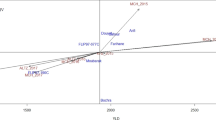Abstract
Chickpea (Cicer arietinum L.) is an important food legume crop grown in arid and semi-arid regions of the world. In India, kabuli chickpea is grown in central India in ~0.5 million ha, predominantly under short winter (< 110 days). Efforts are underway to select promising genotypes at the Food Legume Research Platform (FLRP), Amlaha, located in intensive kabuli chickpea growing area of India. Sixty-four kabuli chickpea lines were evaluated for agronomic traits during 2017–2018 and 2018–2019 crop seasons at FLRP following simple 8 \(\times \) 8 lattice design with two replications. The analysis of variance over two years revealed significant variation exists for days to flowering, plant height, maturity period, biomass, seed size and seed yield. It was observed that with similar maturity time (106 days), FLIP09-432C produced 2273 kg/ha, which out-yielded the popular variety in central India, JGK-3 by 15%. The breeding lines, FLIP09-436C, FLIP09-171C, FLIP09-373C and FLIP09-247C were also found promising for earliness (104–110 days), and high yielding with the good yield ability (1003–2273 kg/ha). These promising genotypes for a short duration with good yield have been selected and can be used for various chickpea breeding programmes to develop high yielding varieties in central India.



Similar content being viewed by others
References
Ahmad Z., Mumtaz A. S., Nisar M. and Khan N. 2012 Diversity analysis of chickpea (Cicer arietinum L.) germplasm and its implications for conservation and crop breeding. Agric. Sci. 3, 723–731.
Ali Q., Tahir M. H., Sadaqat S. A., Farooq J., Ahsan M., Waseem M. and Iqbal A. 2011 Genetic variability and correlation analysis for quantitative traits in chickpea genotypes (Cicer arietinum L.). J. Bacteriol. Res. 3, 6–9.
Bains N. S., Singh S. and Dhillon B. S. 2012 Enhanced utilization of plant genetic resources in crop improvement programmes. Indian J. Plant Genet. Resour. 25, 52–62.
Bharadwaj C., Chauhan S. K., Yadav S., Satyavathi T. C., Singh R., Kumar J. et al. 2011a Molecular marker based linkage map of chickpea (Cicer arietinum L.) developed from desi × kabuli cross. Indian J. Agric. Sci. 81, 116–118.
Bharadwaj C., Srivastava R., Chauhan S. K., Satyavathi C. T., Kumar J., Faruqui A. et al. 2011b Molecular diversity and phylogeny in geographical collection of chickpea (Cicer sp.) accessions. J. Genet. 92, 94–100.
Gaur P. M., Jukanti A. K. and Varshney R. K. 2012 Impact of genomic technologies on chickpea breeding strategies. Agronomy 2, 199–221.
Harlan J. R. 1992 Crops and man, 2nd edition, American Society of Agronomy, Crop Science Society of America, Madison.
Haussmann B. I. G., Parzies H. K., Prester T. and Miedaner T. 2004 Plant genetic resources in crop improvement. Plant Genet. Resour. 2, 3–21.
Kumar T., Bharadwaj C., Rizvi A. H., Sarker A., Tripathi S., Alam A. and Chauhan S. K. 2015 Chickpea landraces: a valuable and divergent source for drought tolerance. Int. J. Trop. Agric. 33, 633–638.
Kumar T., Bharadwaj C., Tiwari N., Satyavathi C. T., Patil B. S., Sarker A. and Alam A. 2018 Morphological characterization and grouping of chickpea (Cicer arietinum) genotypes for drought tolerance. Indian J. Agric. Sci. 88, 1740–1745.
Leport L., Turner N. C., French R. J., Barr M. D., Duda R., Davies S. L. et al. 1999 Physiological responses of chickpea genotypes to terminal drought in a Mediterranean-type environment. Eur. J. Agron. 11, 279–291.
Mohammed A., Tana T., Singh P., Korecha D. and Mollad A. 2017 Management options for rainfed chickpea (Cicer arietinum L.) in northeast Ethiopia under climate change condition. Clim. Risk Manag. 16, 222–233.
Padmavathi P. V., Murthy S. S., Rao V. S. and Ahamed L. M. 2013 Correlation and path coefficient analysis in Kabuli chickpea (cicer arietinum L). Int. J. Appl. Biol. Pharm. Technol. 4, 107–110.
Qureshi A. S., Shaukat A., Bakhsh A., Arshad M. and Ghafoor A. 2004 An assessment of variability for economically important traits in chickpea (Cicer arietinum L.). Pak. J. Bot. 36, 779–785.
Roberts E. H., Summerfield R. J., Minchin F. R. and Hadley P. 1980 Phenology of chickpea (Cicer arietinum L.) in contrasting aerial environments. Expl. Agric. 16, 343–360.
Sharma S., Upadhyaya H. D., Varshney R. K. and Gowda C. L. L. 2013 Pre-breeding for diversification of primary gene pool and genetic enhancement of grain legumes. Front. Plant Sci. 309, 1–14.
Singh M., Bhardwaj C., Singh S., Panatu S., Chaturvedi S. K., Rana J. C. et al. 2016 Chickpea genetic resources and its utilization in India: current status and future prospects. Indian J. Genet. Plant Breed. 76, 515–529.
Singh R., Sharma P., Varshney R. K., Sharma S. K. and Singh N. K. 2008 Chickpea improvement: role of wild species and genetic markers. Biotechnol. Genet. Eng. Rev. 25, 267–314.
Tesfamichael S. M., Githiri S. M., Nyende A. B. and Rao N. V. P. R. G. 2015 Variation for agro-morphological traits among kabuli chickpea (Cicer arietinum L.) Genotypes. J. Agric. Sci. 7, 75–92.
Toker C. and Cagirgan M. 1998 Assessment of response to drought stress of chickpea (Cicer arietinum L.) lines under rain field conditions. Turk. J. Agric. Forestry 22, 615–621.
Upadhyay H. D., Thudi M., Dronavalli N., Gujaria N., Singh S., Sharma S. and Varshney R. K. 2011 Genomic tools and germplasm diversity for chickpea improvement. Plant Genet. Resour. 9, 45–58.
Varshney R. K., Song C., Saxena R. K., Azam S., Yu S., Sharpe A. G. et al. 2013 Draft genome sequence of chickpea (Cicer arietinum) provides a resource for trait improvement. Nat. Biotechnol. 31, 240–246.
Acknowledgement
Authors greatly acknowledge ICAR, IFAD and Govt. of Odisha for providing financial support for this research.
Author information
Authors and Affiliations
Corresponding author
Additional information
Corresponding editor: H. A. Ranganath
Rights and permissions
About this article
Cite this article
Kumar, T., Hamwieh, A., Swain, N. et al. Identification and morphological characterization of promising kabuli chickpea genotypes for short-season environment in central India. J Genet 100, 33 (2021). https://doi.org/10.1007/s12041-021-01280-8
Received:
Revised:
Accepted:
Published:
DOI: https://doi.org/10.1007/s12041-021-01280-8




